WOOD HEAT: THE FIREPLACE
- GOAL:
- The student will understand the advantages and disadvantages of using wood fuel for heating and will see how the fireplace fits into the home energy conservation plan.
.
- OBJECTIVES:
- The student will be able to:
- 1. State the advantages and disadvantages of using wood as a home heating fuel.
- 2. Describe what is meant by the term "seasoning" and state the importance of this process.
- 3. State the efficiency of a typical fireplace and list ways to increase efficiency.
- LESSON / INFORMATION:
- Wood is a renewable resource that may be used as fuel in the home. While some believe that wood is more natural and less harmful than gas or petroleum products, the advantages and disadvantages of using wood as a fuel should be carefully considered.
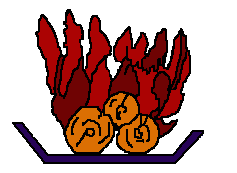
- Advantages
- 1. Wood is a renewable natural resource.
- 2. Wood smoke is relatively nontoxic to the environment, especially with catalytic converters now being used on newer models of fireplaces and wood stoves.
- 3. Wood can be less expensive than some other fuels.
- 4. Wood is used in a variety of wood burning systems.
- 5. When used without a heating system in operation, the fireplace can be more effective, especially on marginally cold days.
- Disadvantages
- 1. Wood can be difficult or costly to obtain.
- 2. Wood is bulky; storage can be a problem.
- 3. Firewood must be seasoned 3 to 6 months.
- 4. Fires must be carefully prepared, tended, and cleared.
- 5. Improperly tended fires can be dangerous.
- 6. Many fireplaces will leak smoke into the home.
- 7. Fireplaces are difficult to seal for air infiltration on the inside and for water leakage from the outside.
- 8. Fireplaces must be inspected regularly for tar and soot build up.
- The type of wood burned, whether hardwood or softwood, is important when examining energy efficiency. Hardwoods have less resin and burn slower and longer, while softwoods burn quickly. In addition to type, the length of time the wood is seasoned is very important when discussing fuel efficiency. Seasoning wood refers to the time it is allowed to dry before being used. As moisture in wood reduces its fuel value, wood dried at least 3 to 6 months is needed to heat a home. Never burn treated wood.
- ACTIVITY 1:
- What is green wood?
- ____________________________________________________________
- ____________________________________________________________
- Burning wet or green wood is inefficient because much energy is wasted in evaporating this moisture. Green wood is wood that has been recently cut and has not had time to cure.
- The drier the wood, the more economical it is to burn. This is a concept better understood after the three stages of combustion have been examined. These stages are as follows:
- 1. Wood heats up and evaporates moisture contained in it. The fire is not giving off much heat at this point.

- 2. Wood breaks down at 500° F and vapors containing 50% to 60% of the heat value are released by 1100° F.
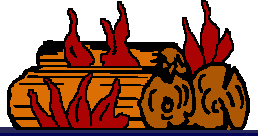
- 3. After the gases burn off and moisture is evaporated, charcoal remains and burns at a temperature exceeding 1100° F.
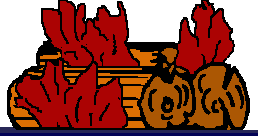
- Thus, the more time and energy wasted in the first stage of combustion where drying takes place, the less heat that is made available for use in the room.
- Do not pick up heat from the fireplace to circulate in the duct system of your central heating/cooling system. This could burn up the compressor, especially in heat pumps.
- Activity 2:
- Is a fireplace an energy efficient way to heat a house? Why or why not?
- __________________________________________________________
- __________________________________________________________
- The United States Department of Energy has shown that only 5% of heat from the typical fireplace is made available for use in the room. This may be somewhat improved by:
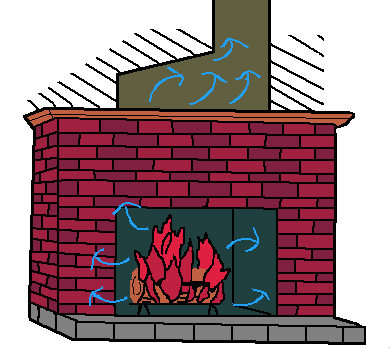
- 1. Adding fireplace accessories such as a convective tube, grate, glass door, or blower.
- 2. Using the fireplace when the outdoor temperature is between 40° F and 50° F. Efficiency goes down at lower temperatures.
- 3. Providing the fire with adequate oxygen and good air circulation from an outside source.
- 4. Closing off the room where the fire is located.
- 5. Using only well seasoned, dry wood.
- 6. Locating the fireplace on an inside wall.
- 7. Turn other heating systems down or off while the fireplace is in use.
- 8. A woodstove or fireplace insert is one of the most effective ways of increasing efficiency.
- 9. Use gas logs.
- ACTIVITY 3:
- Are the following statements facts or opinions about wood heat and fireplaces? Place an "F" before each statement that is a fact and "O" before each statement that is an opinion.
- _____1. Wood is a renewable natural resource.
- _____2. Wood is always the least expensive energy option.
- _____3. The 5% available wood heat probably feels warmer than electric heat.
- _____4. Fires need adequate oxygen and air circulation, preferably from an outside source.
- _____5. A glass fire door is the answer to all wood heat inefficiency problems.
- _____6. Wood smoke is not toxic to the environment.
- _____7. Using wood as an energy source is quick and easy.
- _____8. All people enjoy a beautiful and cozy fire and do not really mind its inefficiency.
- _____9. Fireplaces are needed to make a home feel cozy and warm.
- _____10. The moisture in wood must burn off before the fire gives off heat.
- RESOURCES:
- Wood Heat, Pub. No. 2034. Cooperative Extension Service, Louisiana State University, Baton Rouge, LA, 1982.
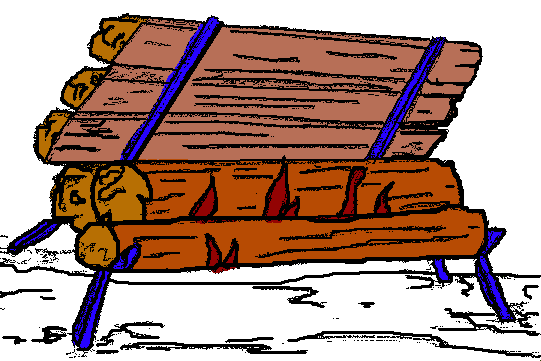
- INFORMATION CHECK
- Underline the correct word or phrase in each pair that best completes the sentence.
- 1. Wood is a (renewable; nonrenewable) natural resource.
- 2. Wood may be used in (one; many) type(s) of wood burning systems.
- 3. Wood should be seasoned at least (1 to 2 ; 3 to 6) months before use.
- 4. As wood begins to heat up and moisture evaporates, it (is; is not) giving off heat.
- 5. Charcoal burns above (110° F; 1100° F).
- 6. The typical fireplace provides (5%; 15%) of its heat for use in the room.
- 7. Fireplaces work better when the outside temperature is (below freezing; moderate).
- 8. (Close; open) the room where the fire is for the most efficient heating.
- 9. Locating a fireplace on an (inside; outside) wall allows more heat to radiate into the home.
- 10. Wood is probably one of the (most; least) efficient of all fuels.
- TEACHER'S NOTES
- ACTIVITY 1:
- Green wood is wood that is wet and will not burn efficiently.
- ACTIVITY 2:
- Examine students' opinions about wood heat.
- ACTIVITY 3:
- 1. Fact
- 2. Opinion - Wood that must be purchased from a retailer is expensive. Or perhaps if one considers all the equipment needed to gather, cut, and prepare firewood, these costs would outweigh the cost of heating oil or electric heat.
- 3. Opinion - The information does not state that any heat source is "warmer" than another.
- 4. Fact
- 5. Opinion - A glass fire door is only one an accessory. Several more are necessary to increase efficiency. Other problems may be due to inadequate air circulation or green wood.
- 6. Fact
- 7. Opinion - Those who cut or stack wood and tend fires may not think that wood heat is quick and easy.
- 8. Opinion - A statement cannot be made regarding what all people enjoy. We cannot know this.
- 9. Opinion - Again, we cannot say what all people need to be cozy and warm.
- 10. Fact
- NOTES / DEFINITIONS:
- 1. Danger of wood heat - There may be danger involved in the cutting and hauling of wood, as well as in the actual wood-burning fire.
- 2. Masonry fireplace - The information presented is based on the popular brick fireplace. Other types of fireplaces, or those fitted with special devices, may be more than 5% efficient.
- 3. Renewable energy source - A source of energy that can be replenished during our lifetime. Wood is a renewable energy source as a forest can be regenerated in 20 to 30 years.
- 4. Seasoning - This refers to the drying of wood. It is inefficient to burn green wood for much energy is wasted in moisture evaporation before heat can be given off.
- ANSWERS TO INFORMATION CHECK:
- 1. renewable
- 2. many
- 3. 3 to 6
- 4. is not
- 5. 1100°F
- 6. 5%
- 7. moderate
- 8. Close
- 9. inside
- 10. least
Comments or questions to: TechAsmt@LA.GOV
Return to Home Energy Menu





